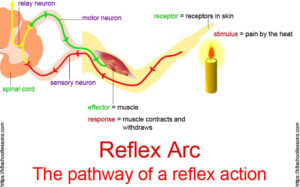Back to: ZOOLOGY 400 Level
Welcome to class!
Hi there, superstar learner! I’m so proud of your journey so far. You’ve been learning how the nervous system sends and receives messages — now let’s see what happens when your body needs to respond quickly, like when you touch something hot! Today, we’re talking about Reflex Pathways and Integration, one of the fastest response systems in your body. Let’s break it down in a simple, relatable Nigerian way.
Reflex Pathways And Integration
Imagine you accidentally touch a hot pot of stew on the fire. Before you can even think “hot!”, your hand has already pulled away. That’s a reflex — a quick, automatic response to a stimulus. Reflexes protect you from harm and help your body react fast without waiting for the brain to decide.

What is a Reflex?
A reflex is an involuntary and nearly instantaneous movement in response to a stimulus. It doesn’t need you to think about it — your body just reacts.
Reflex Pathway (Reflex Arc)
A reflex arc is the route taken by nerve signals during a reflex action. It has five main parts:
Receptor: Detects the stimulus (e.g., pain from heat).
Sensory neuron: Carries the message from the receptor to the spinal cord.
Integration centre (spinal cord): Processes the information — this is where integration happens.
Motor neuron: Carries the response signal from the spinal cord to the muscles.

Effector (muscle or gland): Carries out the response (e.g., pulling your hand away).
This process happens in milliseconds — faster than it would take your brain to analyse and respond.
Types of Reflexes
Simple (Monosynaptic) Reflex: Has just one synapse — like the knee-jerk reaction when a doctor taps below your kneecap.
Complex (Polysynaptic) Reflex: Involves more than one synapse and possibly more muscles — like the withdrawal reflex when you touch something sharp or hot.
Example: Picture a generator with an automatic shutoff. If it gets too hot, it turns itself off without waiting for you to come and press a button. That’s how your reflexes work — automatic protection.

Summary
- Reflexes are quick, automatic responses to stimuli.
- The reflex arc includes a receptor, sensory neuron, integration centre, motor neuron, and effector.
- Integration occurs mainly in the spinal cord, allowing for fast action.
- Reflexes can be monosynaptic (simple) or polysynaptic (complex).
- Reflexes help protect the body from injury without needing the brain’s decision first.
Evaluation
- What is a reflex?
- List the five parts of a reflex arc.
- Where does integration occur during a reflex?
- Give one example of a simple and one of a complex reflex.
- Why are reflexes important for survival?
You’re doing amazing! Now you know how your body protects itself without you even thinking about it — how cool is that? Keep pushing forward, because your knowledge is building stronger every day. With Afrilearn by your side, there’s no limit to what you can achieve. Keep learning, keep shining!
